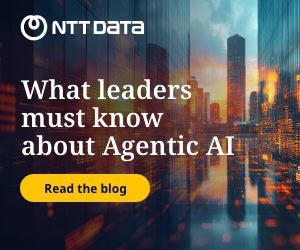The key to unlocking a smarter, more sustainable digital future lies not only in engineering innovations but also in the intelligent integration of IT operations, automation, and data-driven decision-making.
For Bentley Systems, an infrastructure engineering software company, intelligent IT operations are transforming how infrastructure is designed, built, and maintained, creating smarter, faster, and greener outcomes for companies and communities worldwide. Bentley leaders share how technology, innovation, and purpose come together to build the foundations of a smarter, greener world.
Technical transformation

For Andy Rahden, Bentley's vice president for Solution Engineering and Services, the future of infrastructure begins with automation. As infrastructure projects become more complex, Rahden believes that automation, powered by artificial intelligence AI and open platforms, can drive intelligent project delivery.
He also believes that sustainability should begin in the design stage, as poor design can lead to waste in materials, fuel, labour, and time.
"When you have a poorly designed facility, you end up with so much waste on the construction side that you end up having massive downstream impacts when it comes to sustainability. Cleaning up the design process and visualising everything throughout makes it pretty impactful on the sustainability side," Rahden said.
Cleaning up the design process and visualising everything throughout makes it pretty impactful on the sustainability side, Andy Rahden
Additionally, Bentley's Rahden emphasised the importance of AI and cloud technologies to accelerate structural analysis. Faster and more accurate analysis enables better engineering decisions, longer-lasting infrastructure, fewer failures, and longer asset lifespans.
Furthermore, with infrastructure projects generating terabytes of files, intelligent search now enables easier access to files without wasting time searching for data, thereby speeding up delivery. AI-powered search now reads the contents of files and models, not just filenames.
Another factor that helped IT operations advance sustainability is the use of open platforms. For Rahden, it spells stronger collaboration across teams, from design through construction to operations. Embedding AI across its open applications also helped the company eliminate rework and miscommunication between project phases.
As infrastructure becomes more digital, Rahden think that AI, AI agents and automation will continue to shape IT operations. However, he reiterated that despite technological advances in operations, nothing can replace human engineers.
"The concept of replacing a human being or replacing an engineer isn't really what is happening as things progress forward, but rather making that engineer more efficient as they move forward," he said.
Together, these developments show that sustainability does not begin on the construction site, but at the earliest stages of design.
However, the challenge extends beyond tools and workflows. The question now is how regions, especially fast-growing ones, scale these innovations to meet rising infrastructure demand.
Empowering the IT innovation for APAC's infrastructure growth
While Rahden focuses on how technology strengthens the foundation of digital project delivery, Bentley's Asia-Pacific operations show how these innovations translate into real-world outcomes across a region facing rapid urban growth and increasing need for sustainability.

Kaushik Chakraborty, senior vice president, Regional Executive, APAC at Bentley, explained that post-COVID urbanisation and public expectations have accelerated the demand for modern infrastructure across APAC.
Governments now need to deliver bigger, more complex projects in shorter timelines, yet the engineering workforce has not scaled. To help bridge the gap, digital transformation and automation are becoming essential. Digital twins, connected data environments, and collaborative design platforms enable agencies to carry projects from design to long-term operations more efficiently and sustainably.
He explained a significant shift currently happening in the region: "Traditionally, owners are just thinking they have a very CAPEX mindset. What we are seeing today is a more holistic life approach."
This involves designing an asset for decades of operation, including its maintenance and sustainability factors. This new mindset now requires better data continuity from design through construction to operation, as well as open, collaborative platforms that connect many stakeholders in a given project. It also involves bringing maintenance teams into the design phase, not after, and treating digital information as the most valuable asset of a project.
Technology is about supporting people who have a vision and want to make a change. Kaushik Chakraborty
"Technology is about supporting people who have a vision and want to make a change. I think what we want to do is make technology more accessible, make it simpler, make it more affordable, and then support our users to use that for the betterment of what they want," he concluded.
The culture of sustainability
Yet technology alone does not create sustainability. It requires a cultural shift in how organisations plan, design, and manage infrastructure over its full lifecycle. This is where sustainability leadership comes in.

Chris Bradshaw, Bentley's chief sustainability officer, posits that sustainability improvements start with access to accurate data. Digital twins, for example, allow organisations to simulate, test, and optimise infrastructure before construction, thereby minimising waste.
Modern tools also facilitate making carbon-conscious decisions early in the design process. Engineers can see real-time carbon impact as they design. If done later, it will be too late for meaningful change.
Moreover, digital simulation helps reduce truck movements during construction, material hauling, and waste, lowering emissions and operational carbon during the construction phase.
AI also accelerates analysis and decision-making, enabling engineers to spend less time searching and computing and more time solving real problems.
"There's one aspect of AI that we see being very useful for our users, which is sort of the co-pilot assistant kind of capability. An AI agent purpose-built to help infrastructure engineers is focused only on relevant information, not spurious information. That's a productivity game," Bradshaw explained.
An AI agent purpose-built to help infrastructure engineers is focused only on relevant information, not spurious information. That's a productivity game, Chris Bradshaw
Another category of AI-related automation is the ability to perform tasks that were previously impractical or time-consuming. For example, in the areas of optimisation and analysis, AI agents can now compute thousands of permutations in minutes or hours, whereas in the past it would have taken weeks or months. They not only do all the permutations but also identify the best one, as Bradshaw shares.

Rodrigo Fernandes, the company's global sustainability director, added that new technologies can also help identify pattern anomalies and trigger emergency responses, as well as inform strategic decisions on how to prioritise repair.
"The most advanced aspects are computer vision for crack detection in bridges and dams, where you don't need to have people in ropes to see things," he added.
Bentley commits to developing future engineers by recognising the significant intersection between education and sustainability. With the vast talent gap in professions necessary to sustain, design, and build resilient infrastructure, the company provides opportunities for kids and students to learn to build sustainable infrastructure.
Bradshaw shared: "A few other things we attempt to do in the intersection of sustainability and education are to draw young people to create interest by providing curriculum and materials for kids that are project-centric and that are outcomes-based."
"We provide [opportunity] for them to start using an open platform, and they start playing with it, and we challenge them to bring ideas to us on how they can build a better world with our software, and they come to us with amazing ideas," Fernandes said.
Asked about their advice for CIOs wanting to build their first step towards sustainability in their operations, Fernandes said: "I would start by drawing a strategic plan for what outcomes they expect to achieve on sustainability. Once they find it, they should assess where they are to achieve that, and probably they should start small to scale fast."
Once they find it, they should assess where they are to achieve that, and probably they should start small to scale fast. Rodrigo Fernandes
A smarter and greener digital future
Across design, construction, and operations, one theme becomes clear: technology is not replacing human expertise, but enabling people to solve bigger problems with greater clarity, speed, and long-term impact.
Ultimately, intelligent infrastructure is not just about building smarter systems but about building systems that help people, communities, and cities thrive in a world that requires both progress and care.





